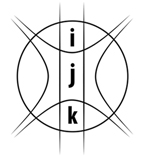2014 (7)
Sunday, 31 July 2016 13:59
The "natural presences" of the symplectic camel II
Written by Mlakár Katalin
Description of the Lorentz transformation with a special scalar and skew-scalar product 1. Summary of antecedents I wrote earlier1 that all the three number-plane one can define a special symplectic form in the same way: ω(z1,z2) = Im(z̄1z2) = x1y2 – x2y1 (1) This is equal to 0 if x1y2=x2y1 i.e. y1/x1=y2/x2, so if the two number-vectors are collinear. _________________________________ 1 See «The "natural presences" of the symplectic camel»
Sunday, 31 July 2016 13:58
The "natural presences" of the symplectic camel
Written by Mlakár Katalin
Skew-scalar product1 and scalar product on the planes of two-element numbers ________________________ 1 A nondegenerate bilinear skew-symmetric 2-form is called skew-scalar product.
Why will we make an error if we are using the concept of Euclidean neighborhood and metric on the hyperbolic plane? In the literature the derivation of the hyperbolic numbers is often introduced by the Euclidean neighborhood and metric on the hyperbolic plane. I present the related problems based on an article1 on the hyperbolic calculus. Quote from the above mentioned article of A. E. Motter and M. A. F. Rosa: “Now we turn to the hyperbolic numbers, P= M2. We employ in M2 the topological structure of R2, this could be seen as contradictory and is criticized (see [9]2). But it is the convention adopted in all the literature (see [10,11] for example) and we assume here this simplified point of view (leaving the…
The 3 +1 dimensions of space-time and two-element numbers The hyperbolic number plane as space-time model is very intuitive, if the space is used only in one dimension. A lack arises however, since we perceive the space as three-dimensional one. Thus we would like to have a kind of numbers – possibly more-element numbers – that it is correctly model the four-dimensional space-time. Yet I think it is far away enough to get a generalization of number concept which includes the two-element numbers presumably as its fundamentals. The geometry helps for this generalization in my opinion but by that I mean the idea is not exactly what today is known as the geometric concept of numbers. In order to develop…
Let two Poincaré's quotation for an abstract: „It has, for instance, been observed that a weight A of 10 grammes and a weight B of 11 grammes produced identical sensations, that the weight B could no longer be distinguished from a weight C of 12 grammes, but that the weight A was readily distinguished from the weight C. Thus the rough results of the experiments may be expressed by the following relations:A=B,B=C,A < C,which may be regarded as the formula of the physical continuum.But here is an intolerable disagreement with the law of contradiction, and the necessity of banishing this disagreement has compelled us to invent the mathematical continuum.”1 "There is no actual infinite; the Cantorians have forgotten this, and that is why…
I always deem the mathematics as ultra-idealization because it does not deal with the time requirements of its procedures. This seems inadequacy in those procedures which have infinite number of steps. With the computers' appearance the analysis of algorithm (determination of the amount of resources such as time and storage) became important. In the pure mathematics the timeless procedures are natural, the complexity theory counts as an exception in this question.
Sunday, 31 July 2016 13:45
The Axiom of Choice and the Continuum Hypothesis
Written by Mlakár Katalin
I am very interested in the relation between the axiom of choice and the continuum hypothesis. In 1900 David Hilbert mentioned the continuum hypothesis as the first between the important mathematical problems. Kurt Gödel and Paul Cohen1 gave the solution in the middle of the twentieth century. We know based on the proof of Gödel and Cohen that the continuum hypothesis is consistent and independent assuming ZF2. The same is true of the axiom of choice. ____________________________ 1I am now reading the book of Cohen, Set Theory and the Continuum Hypothesis /Dover (2008) unabridged republication of the edition published by W.A. Benjamin, Inc., New York, 1966. Copyright renewed 1994 by Paul J. Cohen. 2 Zermelo-Fraenkel Set Theory



